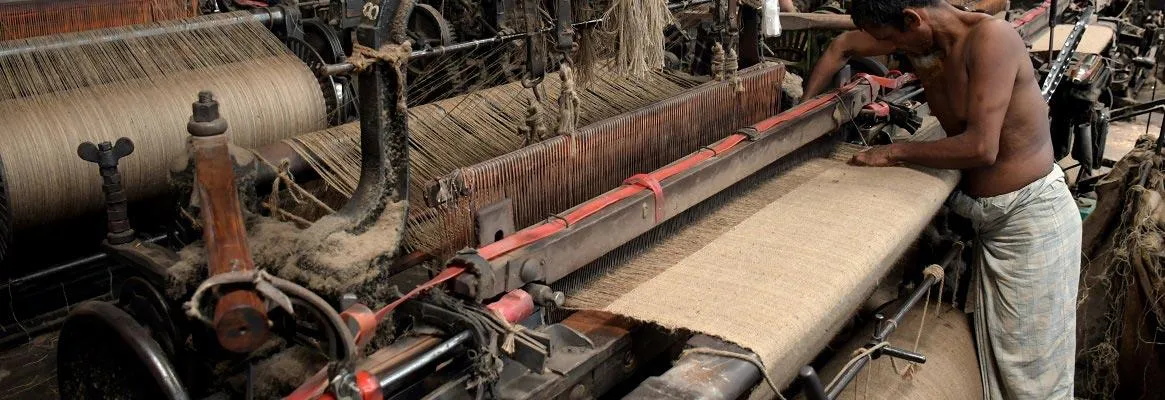Study on Weaving Performance of a Jute Mill in Pre- & Post-COVID Lockdown Periods

Abstract
A comparative analysis of the weaving performance of Bally Jute Company Ltd (BJCL) in pre- and post-COVID lockdown situations revealed the statistically significant difference in Hessian loom productivity. It was found that Hessian loom’s (finer quality fabric) kgs/loom/shift average daily efficiency and actual daily production were significantly different. In case of sacking loom (coarser quality fabric) however, there was no statistical difference in average daily kgs/loom/shift in actual production and loom efficiency. In case of S4 loom, statistically significant differences were observed in loom efficiency.
Study area
To observe the effect of COVID-19 situation in productivity of jute industry, BJCL was selected. The unit is situated on the banks of river Hooghly in the district of Howrah close to Kolkata. It is well connected to rail and road networks. More than 3,000 employees are directly work there. Another 5,000 are indirectly linked with various jobs. Economy of the locality of Bally, Uttarpara, Belur, i.e, some parts of Howrah and Hooghly districts of West Bengal are dependent on the jute industry. Various fine fabrics of jute, bags, yarn of various range of count are the main products of this unit. The unit was closed from March 22 to second week of May last year due to lockdown. After that, it gradually began operations. This unit is representative of the jute industry in West Bengal.
Research methodology
In the pre-lockdown stage, the mill had registered production of the weaving department. The daily hard copy of computer-generated productivity report was available at the weaving department’s office. This data was collected and tabulated. Post-lockdown primary data of 25 days were studied and recorded in the productivity report register. The problems of lower productivity after lockdown stage and possible solutions to overcome them were brainstormed.
Literature rev
The jute industry was under lockdown since March 23. Jute products are under Essential Commodities Act. So the supply of jute bags as packaging material for food grains should have continued to ensure uninterrupted supply. But the state government had put the jute industry under lockdown. At that time Rabi harvesting was under way and the requirement for jute bags was essential. Procurement agencies like the Food Corporation of India (FCI) and different state governments were suffering due to lack of jute bags. The jute industry in West Bengal, with its 2.5 lakh workers, was facing distress. With the boro crop approaching harvest, farmers were to face serious problems. A lot of the orders for jute bags were then diverted to the plastic industry, which had remained exempted from the lockdown [2].
However, farmers and agricultural workers prefer to store their produce in jute bags rather than in plastic ones as the former allow the produce to breathe. Thus, for procurement of food grains, availability of jute bales was immediately required by major procuring states like Punjab, Haryana, Uttar Pradesh (UP) and Madhya Pradesh, where procurement operations were scheduled to start in April. Further, the peak procurement period lasts for only about two to three weeks. Therefore, it was of utmost importance that jute mills immediately resumed operations for manufacturing and dispatching jute bales to meet the requirements. It was declared that 6.1 lakh bales of jute bags were required to meet the demands of the Rabi marketing season.
Due to pandemic, the demand for textile products and sale of domestic products reduced significantly. The textile business community faced cash crunch, supply chain disturbances and manpower-related issues. The mills did not incur raw material and electricity expenses but rest all expenses led to direct loss to the mill owners, who were under stress then to process material of semi-finished and finished products. All shipments were on hold. The labourers were in a dilemma whether to stay back or rush to their hometown if the lockdown was lifted. Majority of them are migrants from Bihar, UP, Orissa etc. Most of the daily wage workers (nearly 80 per cent of the workforce of garment factories) went back to their hometowns. [3]
Results and discussions
Table 1 indicates the productivity status of weaving department of Hessian and sacking loom area. It was found that average efficiency of the machines of Hessian side was 57.41 per cent, whereas that of the sacking loom was 72.38 per cent from December 19, 2019 to January 14, 2020, i.e, before the lockdown. Table 3 shows the Hessian and sacking loom efficiency were 56.83 per cent and 72.24 per cent respectively after the lockdown. So no significant changes in efficiency percentage were observed during the two phases. In terms of kgs/loom/shift, Hessian and sacking loom were 36.41 kgs/loom/shift and 60.71 kg/loom/shift respectively before the lockdown. Maximum and minimum value of sacking loom was 89.42 kg and 58.16 kg before the lockdown. So a wide variation was observed in machine productivity.
From Table 3, it is found that the average productivity of Hessian and sacking loom were 34.18 kg/loom/shift and 58.96 kg/loom/shift respectively. It is quite on the lower side than what was observed during the pre-lockdown stage. The average number of looms before the lockdown was 570/day and 599/day, whereas after the lockdown, it was 529/day and 297/day for Hessian and sacking looms respectively. This figure is much lower than those in before the lockdown. Actual average production/day in July 2020 was much lower than that before the lockdown. That was because most of the employees had returned to their hometowns. External weavers came from other mills and worked regularly. Due to shortage of labourers, fewer looms were running, which led to lower production after the lockdown. So the pandemic had a substantial impact on productivity and machine efficiency of the weaving department.
Useful Links:
